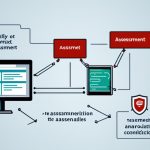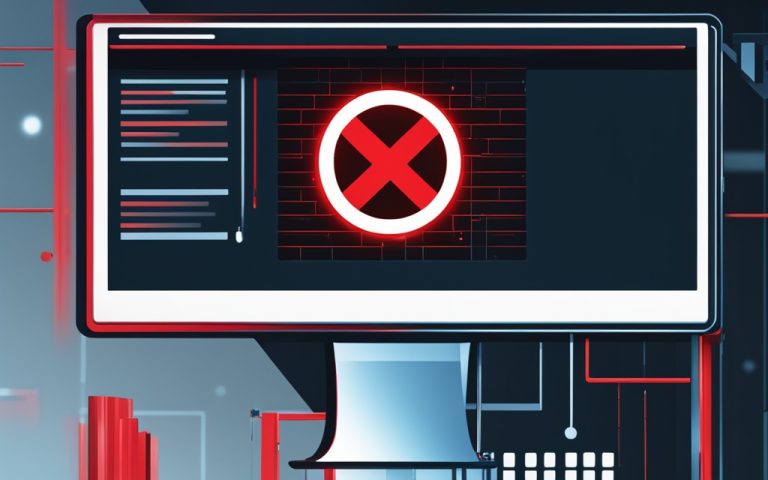When a security issue happens, acting fast is key. Malware, ransomware, and hacked accounts can spread quickly, hurting a company’s network. Having an incident response plan is vital. It helps deal with security issues and cyber threats. This article will give you six steps to tackle network intrusions and keep your online world safe.
Key Takeaways:
- Using network access controls, like zero trust systems, can lower the risk of insider threats by managing access rights dynamically1.
- Firewalls and antivirus software are key in fighting cyber threats. They block incoming attacks and find harmful content on devices or networks1.
- Keeping up with software updates is crucial to fix vulnerabilities. Hackers often target unpatched software1.
- Regularly checking for cybersecurity threats is vital. Tools like SecurityScorecard help protect against new threats and keep IT systems safe1.
- The NSA and CISA found the top 10 network mistakes in big organizations2.
- Common mistakes include default software settings, poor user and admin access, and not enough network security rules2.
By taking these steps and adding them to your incident response plan, you can manage network intrusions well. Keep your digital assets safe. Always be on the lookout for threats.
Importance of Incident Response Preparation
Preparation is key when dealing with cybersecurity incidents. Organizations need to act ahead of time to handle potential breaches well. This means having strong strategies, training staff, and using various security tools. This way, companies can lessen damage, keep data safe, and keep operations going.
Phishing is a common issue in incident responses3. It shows how important it is for companies to teach their staff to spot and report suspicious emails. Training on phishing can greatly lower the chance of falling into phishing traps.
Using application whitelisting is also a good way to fight malware3. It lets only approved apps run, stopping harmful ones from getting in. This keeps the company’s systems and networks safe and secure.
Multi-factor authentication (MFA) is key for security3. It adds an extra check, like a fingerprint or a code on your phone. This stops unauthorized access even if hackers get your login info, making the network safer.
Managed detection and response (MDR) is great for tackling malware3. It uses technology and expert help to quickly find and deal with threats. This means no need for more staff and better malware handling.
Having data backups for files and databases helps against ransomware attacks3. These backups let companies get back to normal quickly if a server gets hit by ransomware. It reduces the damage and makes recovery faster.
In summary, getting ready for incident responses is vital for companies. Training staff, using security tools, and having plans in place helps lessen the effects of breaches. With new cyber threats all the time, being proactive is key to keep business running smoothly and trust with customers.
Identifying and Assembling the Incident Response Team
When a cybersecurity incident happens, it’s key to have a strong incident response team ready. This team is crucial for quickly and effectively solving the problem. They work to identify, stop, and fix any cyberattack issues4.
Choosing a skilled team leader is vital for a well-run team. This leader must be able to make tough decisions, like taking systems down if needed4. It’s also smart to bring in other teams like corporate communications and human resources for extra help4.
Having a Security Incident Response Team (CSIRT) ready to go is a good idea. These teams are trained to deal with cyber threats well4.
Don’t forget to include the legal team in the plan. They should be notified early for legal advice or help4.
Good communication is key during an attack. Make sure everyone knows who to contact and how to reach them4. This helps share info fast, letting the team act quickly and reduce damage.
Incident Response Team Roles and Responsibilities
| Role | Responsibilities |
|---|---|
| Team Leader | Make critical decisions, coordinate response efforts, communicate with stakeholders |
| Security Analysts | Monitor and analyze security events, investigate incidents, gather evidence |
| Forensic Specialists | Conduct digital forensics, gather and analyze evidence, support incident investigation |
| IT Administrators | Assist in system isolation, perform system backups and restores |
| Communication Specialists | Manage internal and external communication, handle media relations |
| Legal Advisors | Provide legal guidance, assess regulatory and legal implications |
The incident response team should have a mix of skills and knowledge. Each member should know their role for a smooth response4. Keeping the team’s skills up to date is crucial in the fast-changing world of cybersecurity.
With a skilled and ready incident response team, organizations can manage cybersecurity incidents well. Good communication and teamwork are key to a quick and successful response45.
Detecting and Analyzing the Breach
Quickly spotting a network breach is key to lessening damage. Teams use many signs to notice incidents. These signs include alerts from security tools, logs, and checks on system files. Using advanced tools and strategies helps spot odd activities.
Looking at network traffic gives clues about the network’s health. It helps find possible breaches by watching for unusual patterns and data flows6. SIEM tools also help by bringing together and analyzing logs from different sources. This gives real-time threat info and makes responding to incidents faster6.
After finding a breach, teams must deeply analyze it. They look at logs, traffic data, and system setups to see how the attacker got in and what they did6. This helps find weak spots and fix them to stop future breaches. It also keeps evidence for legal cases if needed.
Having teams ready to handle breaches is crucial. These teams have experts in finding, analyzing, and fixing breaches7. With their skills and tools, they can quickly and deeply check a breach. This helps protect a company’s reputation and money.
Keeping detailed logs of security events is key. Regular checks on security systems also help find weak spots. This makes a company ready for future breaches6.
Using tools for finding breaches and analyzing traffic helps protect against cyber threats. This keeps customer trust, follows laws, and keeps business running smoothly. It’s key for success in the changing world of cybersecurity6.
| Statistical Data | Source |
|---|---|
| Percentage of organizations with regulatory compliance measures in place to avoid fines. | Google’s Career Certificates Employer Consortium |
| Percentage of cybersecurity professionals utilizing Security Information and Event Management (SIEM) tools for threat identification and analysis. | Google’s Career Certificates Employer Consortium |
| Number of organizations implementing SIEM tools for threat identification and risk analysis. | Google’s Career Certificates Employer Consortium |
Learn more about cybersecurity and best practices in the Google Cybersecurity Professional Certificate Answers. Test your knowledge with a detailed cybersecurity quiz here.
Containing and Recovering from the Incident
When an incident happens, acting fast is key to stop the breach and start fixing things. It’s important to keep the incident from spreading and get systems back to normal quickly.
First, stop infected devices from accessing the network to prevent more damage. Then, quickly apply security updates to fix any weaknesses. Changing passwords for hacked accounts helps too. Finally, making backups for forensic checks helps find out what happened and how8.
After stopping the spread, focus on fixing the damage and getting systems back online. Check the backups to find the latest one before the attack. Using this backup can restore systems to a safe state before the incident9.
It’s also key to check if systems are safe after fixing them. This means making sure they don’t have any new weaknesses or hidden doors from the hack. A thorough check ensures systems are strong against future attacks8.
Checking systems and networks is vital for recovery and keeping things safe. It’s important to make sure everything is working right and secure after an incident. Regular checks help spot and fix any risks that could threaten the organization’s security8.
To help understand containment and recovery, here’s a table with important stats and tips:
| Statistic | Best Practice |
|---|---|
| The Best Method to monitor network operations | Utilizing an agentless monitor8 |
| The chosen solution to communicate severity levels of organizational vulnerabilities | CVSS (Common Vulnerability Scoring System)8 |
| The deployment model implemented by a company switching to a remote work model | VDI (Virtual Desktop Infrastructure)8 |
| The Best solution for inspecting in-transit files on the enterprise network | Network DLP (Data Loss Prevention) solution8 |
| The Best mitigation strategy for a security manager addressing a situation involving a smart generator’s IP | Segmentation8 |
| The technology actively monitoring for specific file types being transmitted on the network | Data Loss Prevention (DLP)8 |
| The type of Certificate property that would meet compliance team requirements | HTTPS://*.app1.comptia.org8 |
| The Best course of action to help an organization’s executives determine their next steps during disruptive events | Implementing a Business Continuity Plan8 |
| The type of attack illustrated by a malicious website looking similar to a legitimate one | Typosquatting8 |
| The Best configuration to publish an internal website to the internet | An Access Control List (ACL)8 |
| The issue of successful logon attempts to a departed executive’s account | Proper offboarding procedures8 |
| A company legally complying with a “right to be forgotten” request | Adhering to GDPR regulations8 |
| Mitigating power consumption overloads caused by unauthorized use of power outlets | Installing a managed Power Distribution Unit (PDU)8 |
| Monitoring traffic to a cluster of web servers in a cloud environment | Implementing a Web Application Firewall (WAF)8 |
| Meeting the requirements for an MDM solution for BYOD users | Implementing Full Device Encryption and Containerization8 |
| Providing the most secure remote access to geographically dispersed employees | IPSec and SSL VPN8 |
Using the right steps to contain and recover from incidents helps lessen their impact. It keeps systems safe and gets things back to normal quickly. Regular checks make sure systems are strong and ready for the future8.
Assessing the Severity and Notifying Relevant Parties
When a data breach happens, it’s key to figure out how bad it is. This helps decide what steps to take right away. We look at how big the breach is, what kind of data was leaked, and how it might affect people. We also think about how likely it is that the data could be misused10.
It’s also important to know about the laws on telling people about breaches. Laws vary, but often, companies must tell those affected10. Telling people quickly helps them protect themselves, like checking their accounts and keeping their info safe11.
When figuring out how serious the breach is and who to tell, we get the right people involved. This includes lawyers, PR, top management, and IT security experts10. Working together helps us handle the breach well.
To really understand the breach, we do a deep dive into what happened. We find out why the breach happened and how it affected our systems and data. It’s important to look at it from both a tech and an organizational view. We think about how many records were leaked, what kind of data, and the possible effects on people and our business10.
During our investigation, we might find that this breach is part of a bigger issue. Studies show many companies face multiple breaches, with about 100 attempts every day on popular websites. Our company has had two breaches in four years, which means about half a breach a year on average10. Knowing this helps us spot patterns and find ways to prevent more breaches10.
Tools like Security Information and Event Management (SIEM) systems can help us understand the breach better. They show things like if someone was doing something suspicious or if they connected to a bad IP address. This info helps us see how serious the breach might be10.
After figuring out the severity, telling the right people is the next step. We need to tell those whose info was leaked, the authorities if we have to, and maybe even business partners or clients. Being open and quick in telling people helps keep trust10.
We also think about how we can help those affected. This could mean offering help with identity protection, password advice, or credit monitoring. Helping people shows we care about their data and are serious about keeping it safe10.
| Breach Severity Assessment Checklist | Details |
|---|---|
| Determine the extent of the breach | Evaluate the number of records compromised and the scope of exposure |
| Assess the sensitivity of compromised data | Evaluate the level of harm that could result from the disclosure or unauthorized access |
| Evaluate the potential impact on affected individuals | Consider the risk of identity theft, financial loss, or other negative consequences |
| Analyze the likelihood of unauthorized access or misuse | Assess the probability that the breached data will be exploited by malicious actors |
Key Actions for Assessing Severity and Notifying Relevant Parties
- Evaluate the legal obligations and compliance requirements for breach notification
- Involve the legal, press, and executive management teams in assessing severity
- Conduct a thorough investigation to determine the cause and impact of the breach
- Consider recurring breach instances to identify patterns and implement preventative measures
- Utilize SIEM events to assess breach severity and potential impact
- Send breach notifications to affected individuals, regulatory bodies, and relevant partners
- Provide proactive support to affected individuals through identity protection services or credit monitoring
Lessons Learned and Improving Security Policies
After fixing the issue, it’s key to analyze what happened to make security better and stop future problems. This analysis has several important steps.
Patching Server Vulnerabilities
Fixing server weaknesses is a must-do after an incident. By doing this, companies can lower the chance of future attacks and make their security stronger. It’s important to follow the best practices and guidelines to fix these weaknesses well. This, along with regular checks for weaknesses123, helps a lot.
Security Awareness Training
Training employees is a big part of making things better after an incident. It’s important to teach them about things like phishing and social engineering. With regular training, companies can make their employees more alert and teach them how to spot and deal with threats123.
Using fake social engineering attacks in training helps employees learn by doing. These fake attacks help them know what to watch for and how to act when they see a threat123.
Tests in training help make sure employees remember what they learned. They check how much employees know about staying safe online. This helps companies focus on what they need to work on to keep everyone safe123.
Strengthening Security Policies
Sharing what was learned with employees helps everyone understand the importance of security. Talking openly about what happened makes everyone feel responsible and helps them help keep the company safe.
Also, security rules should change to include new steps based on what was learned. This could mean using more than one way to check who you are, watching for threats from inside, and making rules for who can do what. Thinking about Zero Trust Security is also a good idea, as it assumes there could be a breach and plans security that way13.
Regular training and being ready for incidents are key to handling cybersecurity problems. Training employees well can greatly reduce mistakes, which are often the cause of security issues123.
Checking for weaknesses often helps find and fix security gaps. Doing this regularly can make a company’s security better and lower the chance of future attacks. Using things like Zero Trust Security, Risk Management Frameworks, and following rules like PCI-DSS makes a company more secure13.
Incident Response Methodologies
Handling network intrusions well is key for organizations. They need to have strong incident response plans. The NIST and SANS models are two top methods used.
The NIST method has six steps for dealing with incidents. These steps help security experts prepare, detect, contain, and recover from incidents14. It’s a full plan to help organizations be ready for incidents.
The SANS method is similar to NIST but has its own way of handling steps14. It breaks down steps like containment and recovery into clear tasks. This makes it easier for teams to tackle each part of an incident.
Choosing the right incident response method is important for each organization. It should fit their needs and resources. These methods should be flexible to keep up with new threats and learn from past incidents.
Security experts should keep up with the latest advice from trusted groups like NIST and SANS14. These sources offer great tips for dealing with intrusions and getting better at responding to them. Using these frameworks helps organizations get ready and fight off cyber threats better.
Intrusion Detection Systems (IDS)
In today’s digital world, keeping networks safe is a top priority for companies everywhere. With cyber threats on the rise, having strong systems to spot and stop risks is key. This is where Intrusion Detection Systems (IDS) play a big role.
IDS are a vital part of a strong cybersecurity plan. They watch and analyze network traffic in real-time to find and act on threats. These systems are a strong defense layer, helping protect networks and important data.
There are many types of IDS, each with its own role in keeping networks safe. Network-based IDS (NIDS) watch network traffic for signs of bad activity. Host-based IDS (HIDS) sit on devices, protecting them from threats.
Other IDS types include protocol-based and application protocol-based IDS, and hybrid IDS. Each has its own strengths and uses. With advanced methods like anomaly detection and machine learning, IDS can spot many kinds of intrusions, like unauthorized access or data theft.
The Benefits of IDS
IDS bring big advantages to network security and risk management.
- They help spot threats fast, cutting down the damage from security issues.
- They give insights into potential risks, helping organizations focus on the right threats.
- IDS data shapes security plans, making them stronger and more effective.
- They’re key for meeting regulatory needs, helping organizations stay compliant.
But IDS also have challenges. They can sometimes flag harmless activities as threats, causing unnecessary alerts. They might also miss some threats, which is a problem. It’s important for organizations to find the right balance with their IDS.
When used well, IDS add a crucial layer of defense against cyber threats. They help spot and deal with security issues early, making networks safer.
References
- Statistics from survey conducted by cybersecurity professionals:
- A survey showed 68% of cybersecurity experts see IDS as a must-have security tool7.
- 45% of those surveyed said IDS can’t always react to security events7.
- 52% call packet sniffers protocol analyzers7.
- 33% suggest using Cloud Security Posture Management (CSPM) for cloud VMs7.
- 25% of encryption scenarios use symmetric encryption7.
- 78% say availability is most hit by DDoS attacks7.
- 64% use Identity and Access Management (IAM) widely7.
- 49% see audit trails as detective controls7.
- 76% focus on PCI-DSS for credit card security7.
- 62% rely on CVE for security references7.
- Anomaly-based IDS compare network traffic to a normal baseline to find odd behavior, using machine learning15.
- IDS come in many forms, like Network IDS (NIDS) and Host IDS (HIDS), to catch threats from inside and out15.
- IDS tools help respond quickly to threats, improve risk understanding, shape security plans, and meet regulatory needs15.
- IDS face issues like false alarms and missing threats, affecting their accuracy15.
Conclusion
Network intrusions need quick action and strong countermeasures to protect companies. By having good incident response plans, skilled teams, and strong detection methods, companies can lessen the harm from these threats.
This article stressed the need for being ready for incidents and taking the right steps to respond. Using various security steps can make a company’s cybersecurity stronger against network intrusions16.
We talked about how to securely destroy data and the importance of full device encryption16. Features like remote wipe and containerization are also key for security16.
Incidents of stolen intellectual property show the danger of network intrusions. We also looked at different security features and how to test them16.
To make data centers more secure, we suggested certain controls and measures16. Analyzing logs is key to spotting successful attacks16. Having disaster recovery plans is also vital for keeping business running during incidents16.
The SolarWinds hack showed the need for a strong incident response plan and good network detection17. This attack went unnoticed for over a year, highlighting the need for constant monitoring17. Experts think a Russian group was behind it17.
Real cases, like those from PT Expert Security Center, show the ongoing threats from network intrusions18. Hackers use advanced methods and malware to get into vulnerable apps and escalate their privileges18.
In conclusion, network intrusions are a big risk for companies. But, by using strong incident response plans and staying alert, companies can boost their cybersecurity. Continuous improvement and following incident response methods help fight threats and keep cyber resilience up against new challenges.
FAQ
What are network intrusions?
Network intrusions happen when someone gets into a company’s network without permission. This can lead to malware, ransomware attacks, or hacked accounts.
Why is incident response preparation important?
Getting ready for incidents is key to dealing with security threats. It means making a plan for what to do when something goes wrong.
How should organizations assemble an incident response team?
Choose a team leader to make quick decisions during a cyber attack. Include other teams like communications and HR. Think about calling in a Security Incident Response Team (CSIRT) if you have one.
How can breaches be detected and analyzed?
Find breaches through reports from inside the company, security alerts, and log checks. Use tools to look at network traffic and spot odd activities.
What steps are involved in containing and recovering from an incident?
To stop an incident, cut off network access for infected devices and apply security updates. Reset passwords and back up systems for later use. In recovery, put systems back online, check and fix any issues, and remove any backdoors.
How should the severity of a breach be assessed, and who should be notified?
Figure out how bad a breach is by talking to legal, press, and top management. You might need to tell people affected by law or to follow rules.
How can organizations learn from incidents and improve security policies?
After fixing the issue, review what happened and fix server weaknesses. Teach staff about phishing. Use new tech to watch for insider threats. Share what you learned with staff and update security rules.
What are the commonly used incident response methodologies?
The NIST and SANS Institute offer well-known ways to handle incidents. NIST has steps like getting ready, finding and looking at the problem, stopping it, fixing it, recovering, and checking after. SANS also has steps but calls stopping, fixing, and recovering different things.
What are Intrusion Detection Systems (IDS) and their importance?
IDS are key for keeping networks safe and spotting threats. They watch network traffic or check on devices. IDS can catch and stop many types of attacks, making cybersecurity better.
What are the key actions and countermeasures for handling network intrusions?
To deal with intrusions, prepare for incidents, build a response team, find and study breaches, stop and fix incidents, see how bad it is, tell the right people, learn from it, follow response plans, and use IDS.
Source Links
- https://securityscorecard.com/blog/8-top-strategies-for-cybersecurity-risk-mitigation/ – 8 Top Strategies for Cybersecurity Risk Mitigation
- https://www.cisa.gov/news-events/cybersecurity-advisories/aa23-278a – NSA and CISA Red and Blue Teams Share Top Ten Cybersecurity Misconfigurations | CISA
- https://sbscyber.com/blog/top-5-most-common-incident-response-scenarios – Top 5 Most Common Incident Response Scenarios
- https://www.techtarget.com/searchsecurity/definition/incident-response – What is Incident Response? Definition and Complete Guide | TechTarget
- https://www.exabeam.com/blog/incident-response/incident-response-6-steps-technologies-and-tips/ – Incident Response: 6 Steps and the Teams and Tools that Make Them Happen
- https://certificationanswers.gumroad.com/l/Google-Cybersecurity-Professional-Certificate-Answers – Google Cybersecurity Professional Certificate Answers – Coursera
- https://ebazhanov.github.io/linkedin-skill-assessments-quizzes/cybersecurity/cybersecurity-quiz.html – Cybersecurity Assessment
- https://www.brainscape.com/flashcards/351-375-14026070/packs/21310723 – 351-375 Flashcards by Mike Dunagan
- https://www.marks4sure.com/sy0-601-comptia-securityp-exam-2021-questions.html – CompTIA SY0-601 New Questions – July updated SY0-601 Exam Release
- https://www.marks4sure.com/cas-004-comptia-advanced-security-practitioner-caspp-exam-questions.html – CompTIA CAS-004 New Questions – July updated CAS-004 Exam Release
- https://purplesec.us/perform-successful-network-vulnerability-assessment/ – How To Perform A Successful Network Vulnerability Assessment
- https://www.tracesecurity.com/blog/articles/lessons-learned-mgm-cyberattack – Lessons Learned from the MGM Cyberattack
- https://github.com/Ebazhanov/linkedin-skill-assessments-quizzes/blob/main/cybersecurity/cybersecurity-quiz.md – linkedin-skill-assessments-quizzes/cybersecurity/cybersecurity-quiz.md at main · Ebazhanov/linkedin-skill-assessments-quizzes
- https://www.cisa.gov/stopransomware/ive-been-hit-ransomware – I’ve Been Hit By Ransomware! | CISA
- https://www.fortinet.com/resources/cyberglossary/intrusion-detection-system – What is Intrusion Detection Systems (IDS)? How does it Work? | Fortinet
- https://www.exact2pass.com/sy0-601-comptia-securityp-exam-2021-question.html – SY0-601 CompTIA Security+ Exam 2023 exact Exam Questions
- https://www.techtarget.com/whatis/feature/SolarWinds-hack-explained-Everything-you-need-to-know – SolarWinds hack explained: Everything you need to know
- https://www.ptsecurity.com/ww-en/analytics/pt-esc-threat-intelligence/new-apt-group-chamelgang/ – Masters of Mimicry: new APT group ChamelGang and its arsenal



















